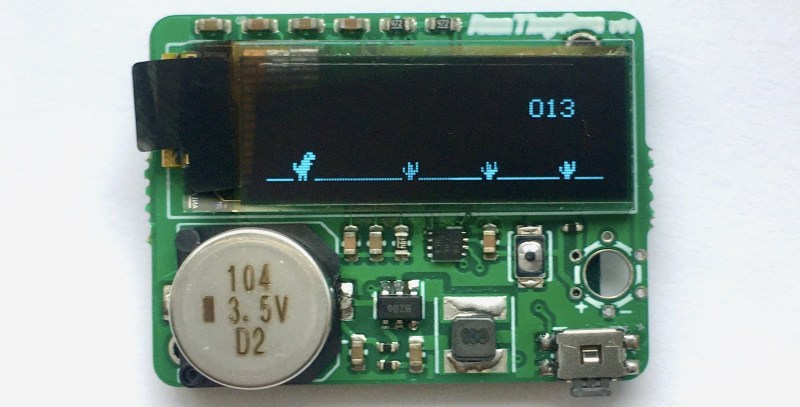Fully solar-powered handheld gadgets have so far mostly been limited to ultra-low power devices like clocks, thermometers and calculators. Anything more complicated than that will generally have a battery and some means to charge it. An entirely solar-powered video game console is surely out of reach. Or is it? As [ridoluc] shows, such a device is actually possible: the RunTinyRun gets all its power directly from the Sun.
To be fair, it’s not really a full-fledged game console. In fact it doesn’t even come close to the original Game Boy. But RunTinyRun is a portable video game with an OLED display that’s completely powered by a solar panel strapped to its back. It will run indefinitely if you’re playing outside on a sunny day, and if not, letting it charge for a minute or two should enable thirty seconds of play time.
The game it runs is a clone of Google’s Dinosaur Game, where you time your button presses to make a T-Rex jump over cacti. As you might expect, the game runs on an extremely minimalist hardware platform: the main CPU is an ATtiny10 six-pin micro with just 1 kB of flash. The game is entirely written in hand-crafted assembly, and takes up a mere 780 bytes. A 0.1 farad supercap powers the whole system, and is charged by a 25 x 30 mm2 solar cell through a boost converter.
RunTinyRun is a beautiful example of systems design within strict constraints on power, code size and board area. If you’re looking for a more capable, though slightly less elegant portable gaming console, have a look at this solar-powered Game Boy.



















I didn’t know hypercube solar cells were a thing… /s
Is that a Jumposaurus Rex? Haven’t seen one of them since dubya-dubya-two.
I need this so desperately. I think this project is ripe for a kickstarter.
The problem with such projects is that nothing happens to them. People are happy to write anything in assembler. They will race to write that game in half the code. I can assure you that will happen.
But for that to happen, 2 assumptions must be met:
a) it must be available as a kit or off-the-shelf
b) it must be open source and flexible enough to run something else on it.
One will make a calculator, the other a game. But there is no way to buy it. The most important thing is to have some standard. Arduino is a standard and a lot of software is created because everyone knows how it works.
I would like to buy such hardware myself. It is a great tamagotchi. Let it have 5-10 buttons, packaging, access to charging information, ability to control power supply and timing. Let it be small and cheaper than the first raspberry pi or c.h.i.p.
“entirely solar-powered” and OLEDs don’t mix well – would be fun to see this on an e-paper display with partial refresh, or a memory LC display.
SSD1306 / SSD1309 support various scrolling and offset features, so it may be possible to update only locally and achieve higher frame rates.
“A 0.1 farad supercap powers the whole system”. Sure it’s “entirely solar powered” but you could charge a PSP with a tiny solar cell given enough capacitance and time. But that kinda defeats the point of it. The minimum standard is something like a solar powered calculator. IE It it will operate instantly and fully with a reasonable light source without any noticeable charge time. The OLED display is a poor choice for a solar application. A Sharp memory LCD would be much more practical. Also the attiny would have to be dynamically clocked. Any wasted cycle is wasted energy. In the 80’s, Bandai used to sell such things.
https://www.youtube.com/watch?v=x-2HGasFGKQ&t=69s
I would love to see this on a Pinecil!